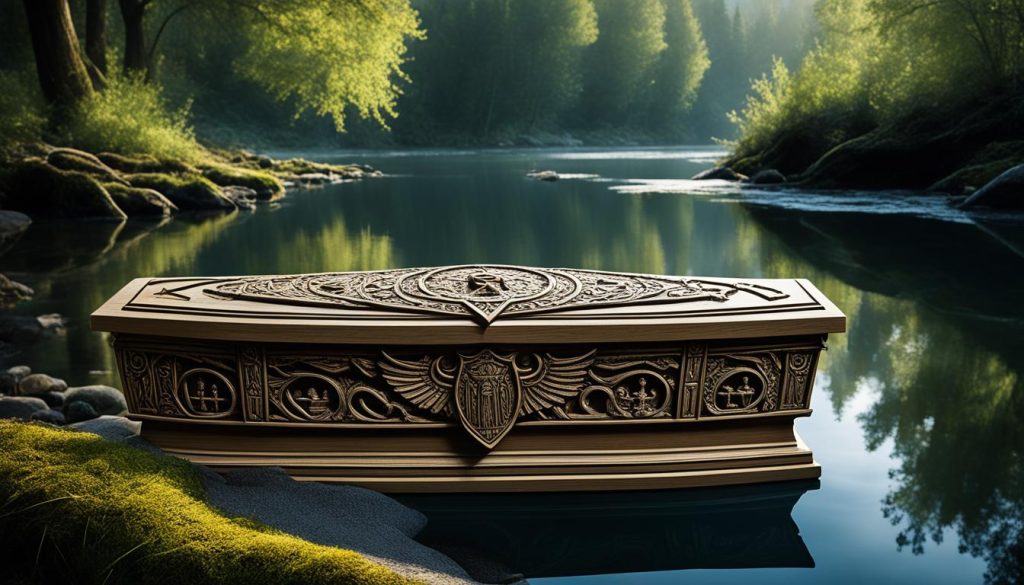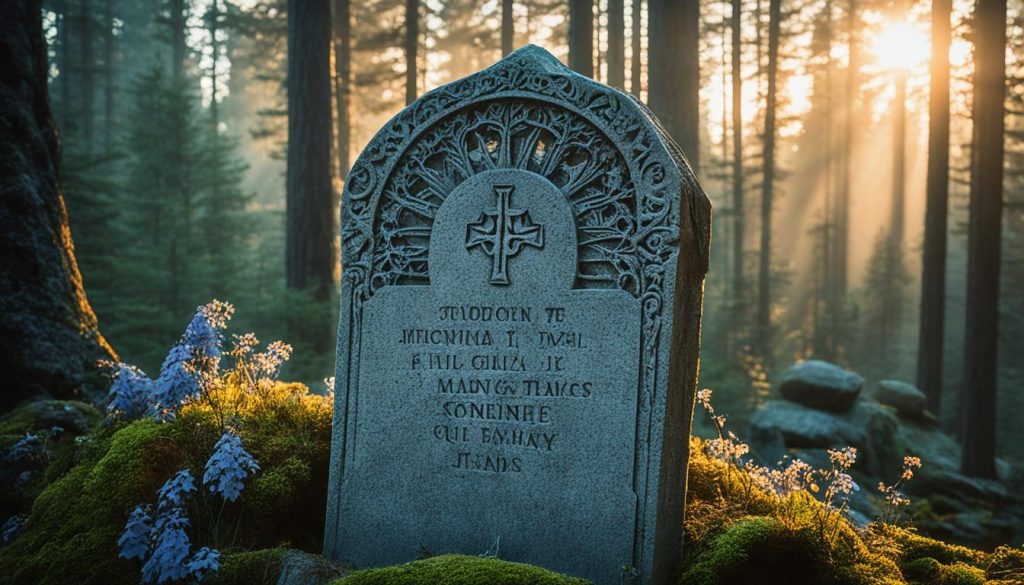The mystery of death has perplexed and captivated human minds throughout history. With its profound and inevitable presence, we have sought to understand and interpret death through a variety of spiritual symbols.
What do these symbols reveal about the symbolism of passing and the significance of mortality in spirituality? How do these cultural icons of the afterlife represent transitions in death? Let’s delve into the realm of spiritual symbolism and explore 30 popular symbols from different cultures that shed light on the enigmatic nature of death.
Key Takeaways:
- Spiritual symbols of death offer insights into the meaning and representation of mortality in different cultures.
- These symbols provide comfort and help individuals navigate the transitions associated with death.
- Understanding the cultural icons of the afterlife allows us to contemplate the mysteries of death and the continuation of existence beyond the physical realm.
- Exploring the symbolism of passing can help us come to terms with the inevitability of death and find solace in the concept of an eternal journey.
The Grim Reaper: Symbol of Death and Transition
The Grim Reaper is one of the most common symbols of death, depicted as a skeletal figure wearing a dark robe and carrying a scythe. Originating in Europe during the Black Death, the Grim Reaper represents the inevitability of death and destruction.
While often seen as a fearsome figure, the Grim Reaper can also be viewed as a guide who escorts the souls of the dead to the afterlife, providing comfort and helping individuals accept the impermanence of life. In many cultures, the Grim Reaper is associated with the idea of a psychopomp, a divine being that guides souls to the realm of the dead.
“The Grim Reaper is a powerful symbol that reminds us of our mortality and the fragility of life. It serves as a constant reminder to make the most of our time and embrace the transition that death brings.”
Throughout history, the symbolism of death has been deeply rooted in various cultures, and the Grim Reaper stands as one of the most recognizable and universal symbols. Its image and presence in folklore, art, and literature serve as a reminder of the journey all souls must undertake. The Grim Reaper signifies not only the end of life but also the beginning of a new spiritual chapter.
Next, we will explore the significance of another powerful symbol of mortality, the skull, and its various cultural representations throughout history.
The Skull: Symbolizing Mortality and Protection
The skull is a powerful symbol of death found in various cultures throughout history. It represents mortality, reminding us of the fragility and impermanence of life.
In some cultures, such as ancient Egypt, skulls were used as a reflection of the Latin expression Memento Mori, which means “remember that you will die.” Memento Mori is a philosophical concept that serves as a reminder to live with the knowledge of judgment after death. The skull, in this context, is a symbol meant to prompt individuals to contemplate their own mortality and make the most of their time on earth.
Additionally, the skull can symbolize protection and power. For centuries, people have believed that wearing a skull amulet can guard against evil spirits and offer spiritual protection. The skull serves as a talisman, an object believed to possess mystical powers, warding off negative energies and ensuring the safety of the wearer.
| Symbolism of the Skull | Meaning |
|---|---|
| Mortality | Represents the inevitability of death and the transience of life. |
| Memento Mori | Reminds individuals to live with the knowledge of judgment after death. |
| Protection | Believed to guard against evil spirits and provide spiritual protection. |
The Coffin: Signifying Final Rest and Spiritual Journey
Coffins hold a profound cultural significance in funeral rituals around the world. These symbolic containers provide a respectful and final resting place for the deceased, honoring their transition from the living world to the afterlife.
Adorned with personal items or mementos, coffins serve as a physical representation of the individual’s life and hold sentimental value for the bereaved. They allow family and friends to pay their last respects and create a meaningful connection with their loved one’s memory.
Beyond their practical purpose, coffins also carry a deep symbolism. They represent the separation between the realm of the living and the departed, as individuals embark on their spiritual journey. Coffins create a clear distinction between the physical world and the afterlife, affording the grieving process a tangible point of transition.
By providing a temporary resting place for the soul, coffins facilitate the separation between the deceased and the living. This spiritual separation allows the bereaved to come to terms with the loss and begin the healing process.

The Tombstone: Memorializing Legacies and Permanence
Tombstones have played a significant role in marking graves and honoring the deceased throughout history. But they’re more than mere symbols of death; they represent the enduring legacy of individuals. Tombstones stand as testaments to the fragility and brevity of life while simultaneously immortalizing the impact that individuals leave behind. Acting as physical markers, they ensure that the memory of the departed lives on for future generations.

Tombstones serve as a link between the past and the present, providing a space for loved ones to remember and pay their respects to those who have passed away. They offer a place for reflection and contemplation, reminding us of the stories, accomplishments, and contributions of the deceased. Whether intricate and ornate or simple and understated, tombstones commemorate lives lived and legacies left behind.
Vultures and Skeletons: Powerful Symbols of Death and Rebirth
Vultures and skeletons are powerful symbols of death that hold significant meaning in various cultures worldwide. These symbols represent the eternal cycle of life, death, and rebirth, as well as the concepts of cleansing and renewal.
Vultures, often associated with death due to their scavenging nature, play a crucial role in maintaining the ecological balance by feeding on decaying carcasses. In many mythologies, vultures also symbolize the transformative power of death and purification. Their ability to transform death into life through the process of decomposition represents the cyclical nature of existence, where something must die for something new to be born.
Skeletons, on the other hand, represent the transience of life, decay, and the afterlife. These bony structures serve as a reminder of the impermanence of our physical bodies. Yet, they also symbolize the enduring essence of the soul that transcends death. In different cultures, skeletons are often celebrated as a representation of rebirth and the continuation of life beyond death.
One of the most well-known celebrations that honor skeletons is the Mexican festival known as the Day of the Dead (Dia de los Muertos). During this colorful and vibrant event, skeletons, known as calacas or calaveras, take the spotlight. They are depicted in various forms, including vibrant sugar skulls and intricately designed skeletal figures. The festivities surrounding the Day of the Dead serve as a profound reminder of the interconnectedness of life and death, and the belief in the eternal nature of the human spirit.
As symbols of death and rebirth, vultures and skeletons invite us to contemplate the transient nature of our existence and embrace the continuous cycle of life. They remind us that death is not an end but a part of a profound transformation, leading to renewal and the opportunity for new beginnings.
Quotes:
“The vulture is a symbol of purification. Just as it cleanses the earth of decaying flesh, it reminds us to release what no longer serves us for our personal growth and spiritual evolution.” – Anonymous
“Skeletons are the silent storytellers of our mortality. They remind us to embrace the fleeting nature of life and live each moment to the fullest, for it is in death that we truly appreciate the gift of life.” – Unknown
Signs from Heaven: Symbols of After-Death Communication
After the loss of a loved one, many people find comfort in the belief that they receive signs from heaven as a form of after-death communication. These signs are often seen as profound messages, reminding us that our departed loved ones are still with us in spirit.
These signs can manifest in various ways, such as seeing butterflies or rainbows, encountering specific animals, or witnessing recurring numbers that hold personal significance. These symbols from the universe are believed to be messages from our loved ones, offering reassurance and guidance from beyond the physical realm.
In addition to these tangible signs, after-death communication can also occur through synchronicities and serendipitous encounters. These unexpected moments of connection and alignment can serve as powerful reminders that our loved ones are still present in our lives, guiding us along our journey even after their passing.
Furthermore, dreams and visitations play a significant role in after-death communication. Many individuals report vivid dreams in which they encounter their departed loved ones, providing solace and a sense of continued connection. These visitations can bring comfort and reassurance, allowing us to maintain a bond with those who have passed away.







